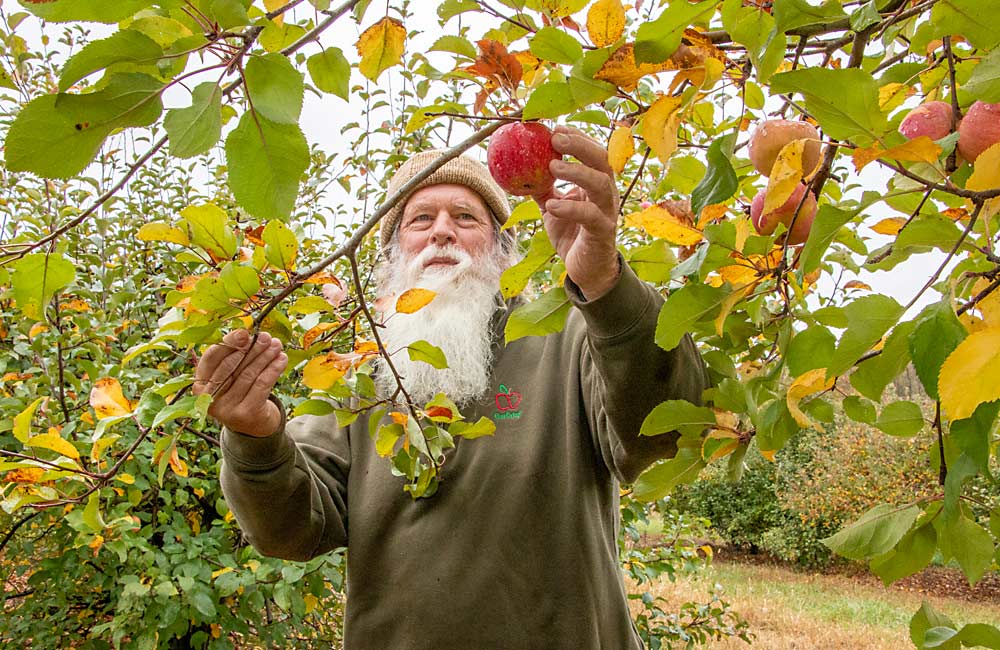
Twenty years after the first seedling that would become MAIA1, the apple marketed as EverCrisp, was planted in a quiet, quirky Indiana orchard, growers have planted more than 1.7 million trees in 728 orchards across the United States.
Those orchards range from large companies with high-density investments to the small, farm market growers the Midwest Apple Improvement Association’s founders had in mind when they launched their breeding and evaluation efforts — and where MAIA1 found its first success.
The EverCrisp program’s business model — building a groundswell at the farm market level and hoping demand rises from there — contrasts strongly with the Cosmic Crisp model, where the Washington state industry used its combined marketing muscle to introduce the variety at scale on grocery shelves across the country.
The contrast looks even stronger when you realize where the EverCrisp originated: a tiny orchard in Wabash County, Indiana, tended by a grower whose methods and mindset might be called the antithesis of cutting-edge.
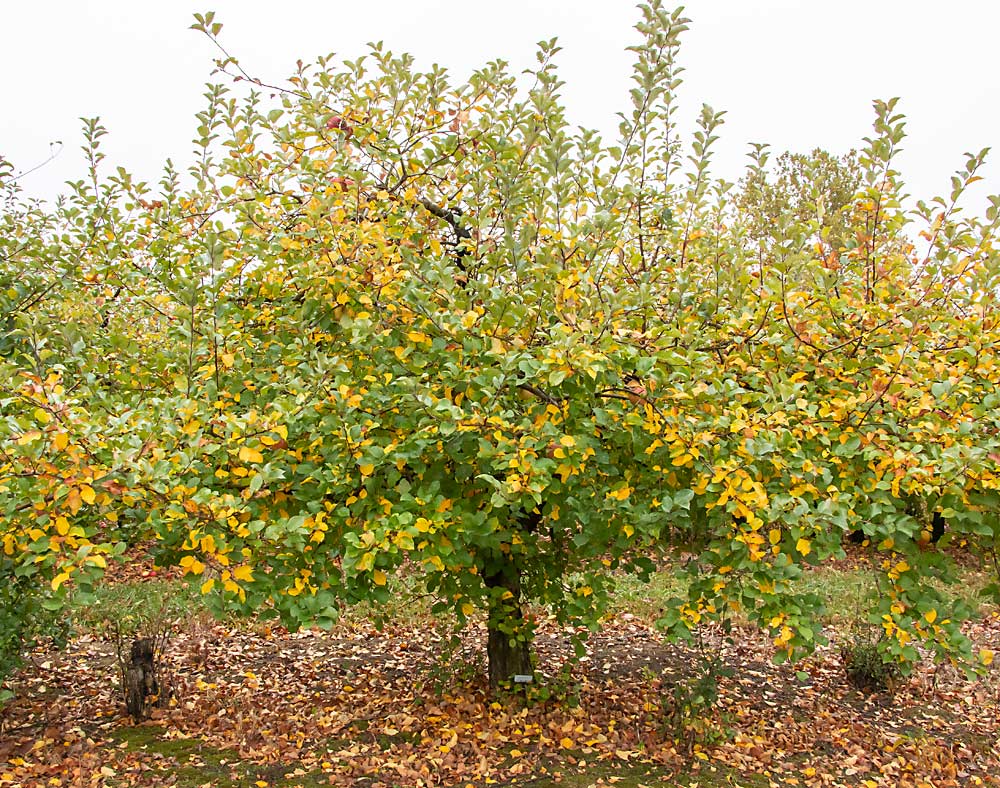
David Doud, 67, owns David Doud’s Countyline Orchard with his wife, Valerie. It’s a small operation, consisting of a modest farmhouse, a no-frills market and about 15 acres of fruit — mostly apples, but also some peaches, pears and strawberries. During a visit with Good Fruit Grower last October, the couple walked through their “odd-shaped parcel,” as Doud called it, and described the unusual year that was 2020.
It started with the coronavirus pandemic in March. Then a freeze in early May killed almost 90 percent of their apples and pears, including most of their MAIA1s. The next month, they invited customers to pick strawberries from their modest patch, as they do every year. So many showed up that they had to shut it down 10 minutes after opening.
“It was crazy,” Valerie Doud said. “There was nowhere to park. We ran out of places to put people.”
After the freeze, David Doud had to decide what to do about his extremely small tree fruit crop. He decided to harvest and sell what few pears and apples he had left, and order some extras from other orchards, but even with that they only kept their market open two days a week in the fall. Operating with masks and limited hours, their main goal was to get their fruit out the door without getting sick.
Their location is not ideal for growing apples: Central Indiana gets its winds straight from the Canadian prairies, without the protection of Lake Michigan. Freeze events are common. He lost his entire crop in 2012, and most of it in 2020. Local orchards have dwindled from dozens to just a handful.
“Good sites in Michigan have a crop this year,” Doud said. “I do not. I like being here, but recognize that, economically, this is not where you want to be growing apples.”
EverCrisp
In a back corner of the orchard, ranked in a row of similar-looking trees, stands the MAIA1 ortet, the original seedling. It’s one of 320 trees in this particular block, all Fuji-Honeycrisp crosses Doud received from MAIA. The block has yielded a lot of “wonderful varieties,” he said.
MAIA1’s keeping ability — its tendency to taste better the longer it’s been in storage, or even sitting on the counter at room temperature — made it stand out in this exceptional crowd. Doud sent several samples of the Fuji-Honeycrisp crosses to other MAIA members in 2008, seven years after the trees were first put in the ground. The group chose MAIA1 as its first release, branding it as EverCrisp.
In mid-October 2020, what was left of his MAIA1 crop was still hanging on the trees. The variety’s picking window is fairly long, running from mid-October to early November in central Indiana. The fruit increases in sugar and quality the longer it hangs. In a normal year, the Douds sell EverCrisps into December or even January, but last fall they planned to pick them and get them off their hands as quickly as possible.
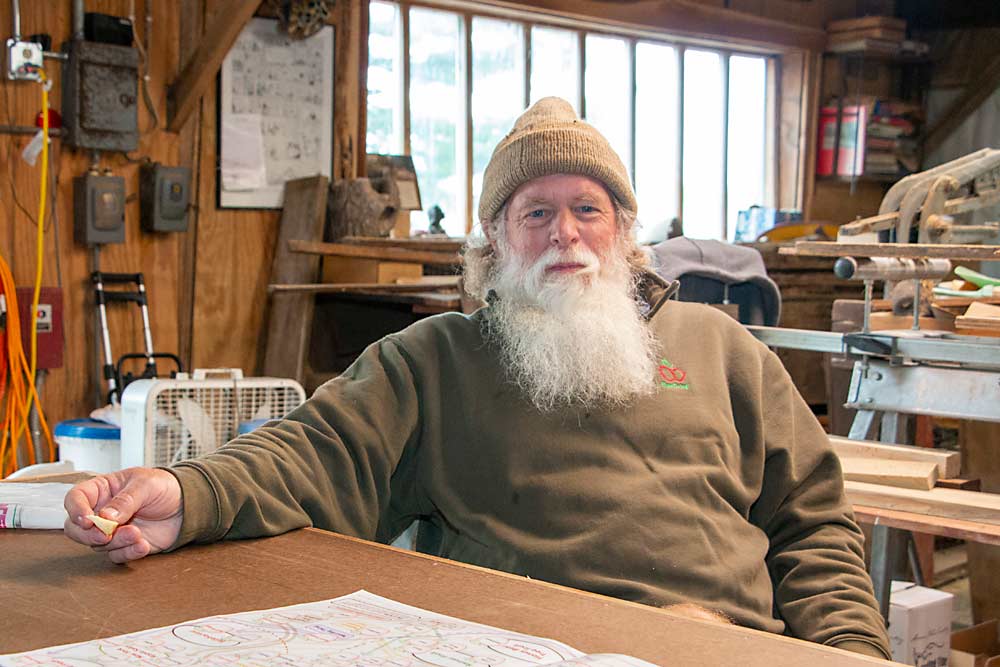
EverCrisp, with its keeping ability and consistent quality, seems like an ideal fit for grocery stores wanting to sell apples in late winter and spring, but there’s a lot of competition in the produce aisles, and the coronavirus upended everybody’s marketing plans, Doud said. But, he’s optimistic about its chances in the long run.
“This is a world-class piece of fruit,” he said. “It’s going to have a home.”
The EverCrisp apple has proven to be popular with farm market consumers — a popularity that gives the brand the potential to carve out its own niche in the wholesale marketplace, said MAIA President Bill Dodd.
“We’re very pleased with how everything has worked out,” he said, citing over 700,000 trees sold in 2020 and the first international commercial planting in Chile.
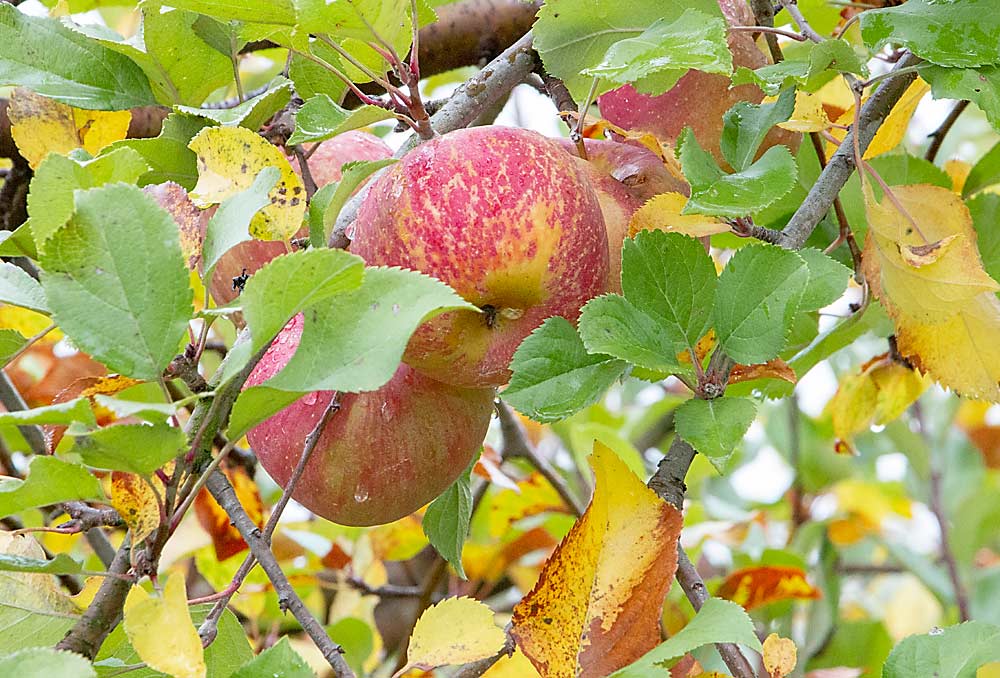
MAIA1 management recommendations
After 20 years of experience with the seedling that would become known as MAIA1, or EverCrisp, David Doud shares some insights into managing it:
—MAIA1 is not particularly difficult to grow, but it has two main management challenges: season and appearance.
—It’s a late-season apple that can hang on the tree for a long time, but the danger is that cold temperatures in late October or early November can affect maturity. Don’t wait too long to pick them.
—MAIA1 can have an acceptably attractive appearance, but it’s a heavy, tip-bearing apple growing on limber limbs that tend to fold down on top of each other, which can result in marginally colored, unacceptable fruit. Shorten and stiffen the limbs to avoid this problem.
—When it comes to thinning MAIA1, there are still more questions than answers. You want a lighter crop load for better color and maturity, but chemical thinning is not currently recommended. Use pruning and hand thinning.
Roots and branches
Those in the apple industry who know Doud acknowledge that he’s not a typical grower, but they say he’s been a role model in many ways — in Indiana and beyond.
“Keeping up with the latest trends in high density or this or that is not what motivates David,” said Peter Hirst, a Purdue University professor of horticulture and extension specialist who’s known Doud for years. “What really motivates him is developing a new apple that takes off over the next 30 years or so.”
Doud’s belief in MAIA’s mission and his focus on the industry’s future are an integral part of the group’s culture, Dodd said. MAIA was founded more than two decades ago by Midwestern growers concerned about lack of access to proprietary varieties.
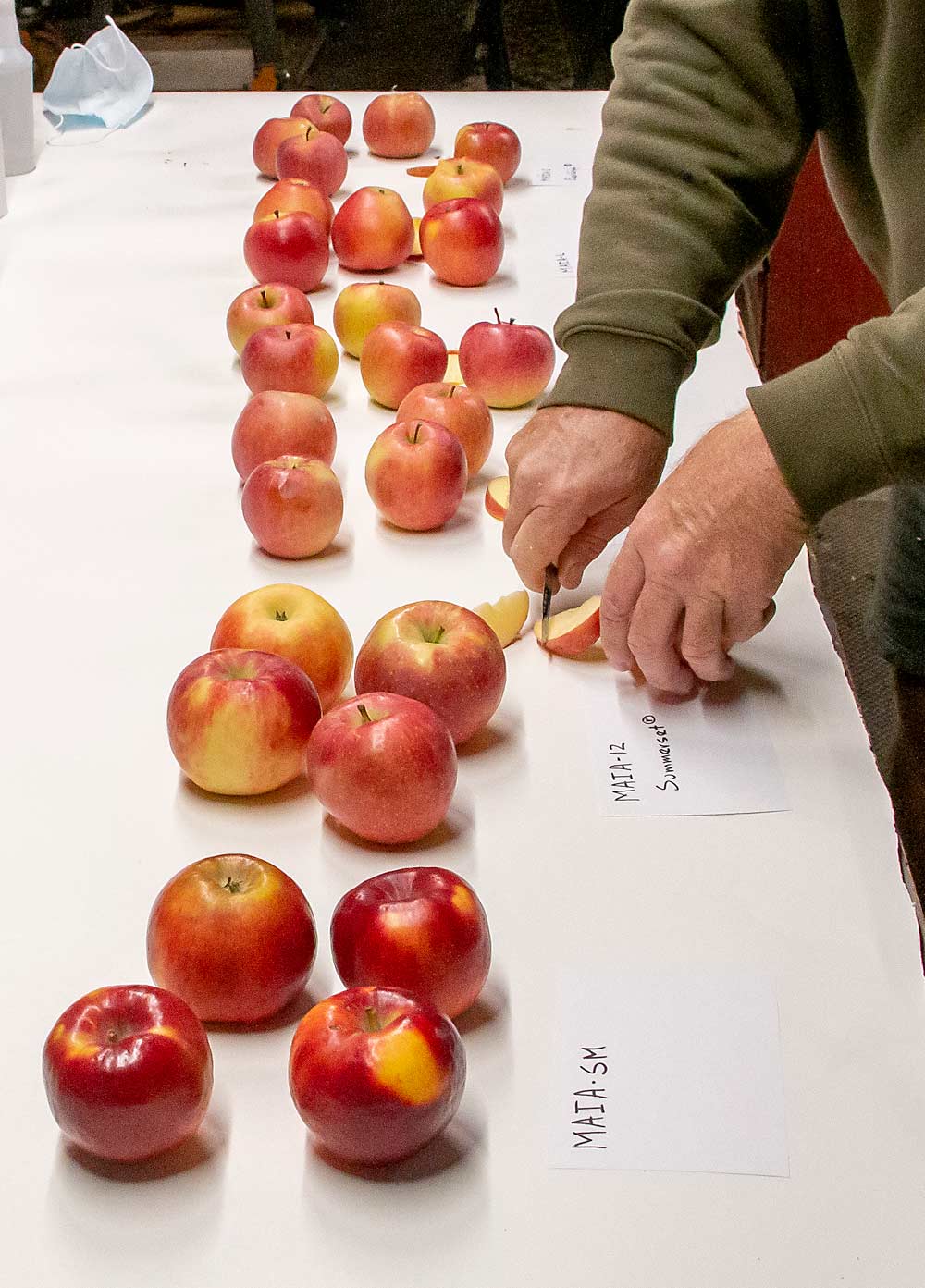
“The leadership role he’s taken has been incredibly important to the advancement of MAIA,” Dodd said. “The things we’ve accomplished are because of a whole bunch of people like David Doud.”
Doud’s roots in central Indiana go back generations. He grew up across the road from his orchard, playing in the “woods and creeks.” He loved it so much he decided to stay. His father, Lorne J. Doud, was an orchardist and nurseryman, and one of the founders of the group that became the International Fruit Tree Association. Doud’s brother ran his own orchard 8 miles to the west. He sold it in 2019 and now lives next door to Doud.
Standing in his orchard last fall, Doud expounded on his growing philosophy. He grows about 50 total apple varieties on various rootstocks. His trees could be called semidwarfing, but they’re hard to describe precisely. The lack of uniformity in his rows is conspicuous.
“Nothing sticks out like a sore thumb here because the whole thing is semiwild,” he said.
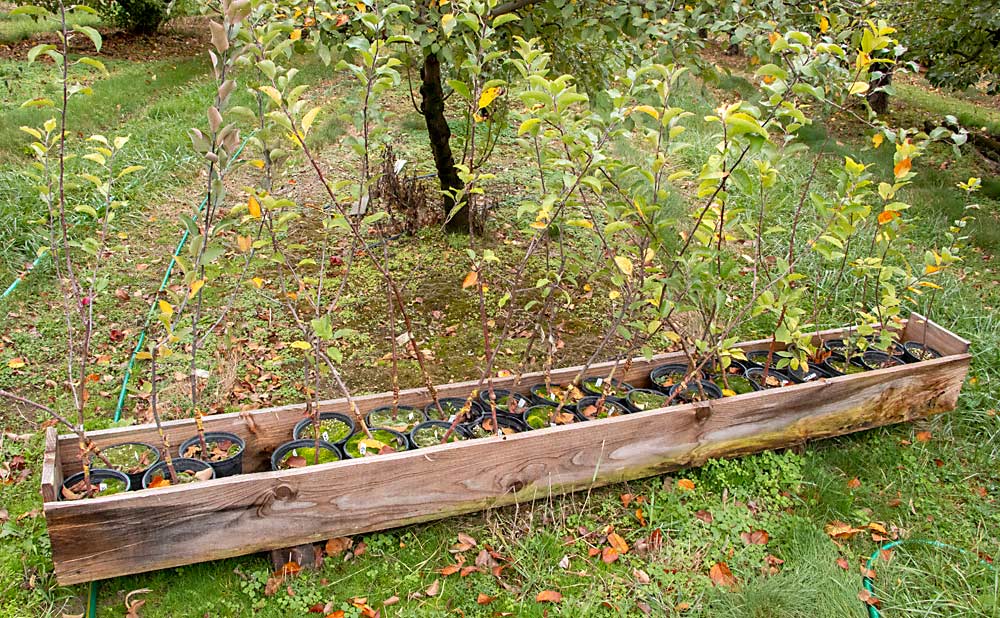
When asked about spacing, Doud sighed, took deliberate steps between two trees and said there were about two paces between them.
“I’ve never used a tape measure on this farm, and some places it shows,” he said. “Rank and file has never been my style. My style is paces, and maybe add an extra half a pace if I feel like it.”
He’s not against high-density plantings, trellises and posts, precision crop load management or mechanization. He admires growers who can make all of that work. He just doesn’t think it makes any sense for his farm. Doud, who does most of the orchard work himself, prefers apples to be within reach, either from the ground or from a 6-foot ladder. He likes to walk between rows. He uses a self-propelled Brownie platform to help him prune, but that’s about as far as he goes with mechanization.
“I don’t get the yield per acre of tall spindle, but I don’t need it,” he said. “I need ease of maintenance.”
Doud bench-grafts trees himself, sitting near the wood stove in his barn, and plants them himself with a shovel, about 200 to the acre. He has to wait a few years for them to crop, and they certainly don’t yield as much as precision-managed, tall spindle trees would, but he’s not carrying thousands of dollars of debt on them, either. In a normal year, he hires two or three local men to help him pick apples. Valerie handles most of the market sales. Their frugality — in addition to Valerie’s longtime job as a biology teacher — helped them survive tough years. And his no-frills approach to growing fruit has not affected its quality.
“My apples are exceptional, if I do say so myself,” he said.
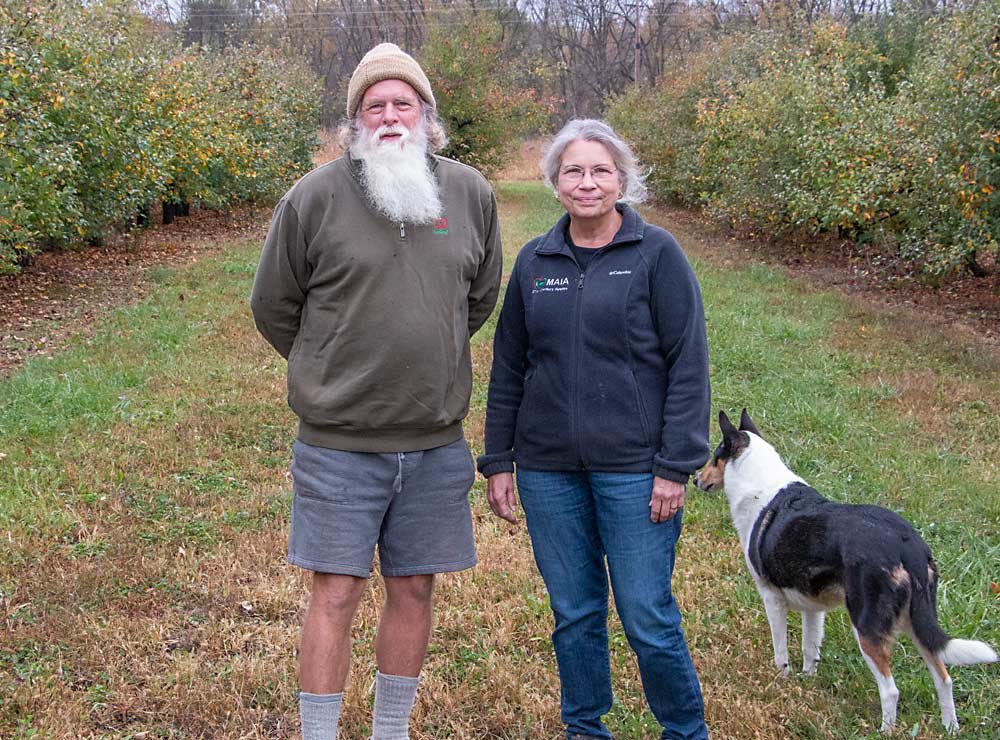
He’s not sure about the orchard’s future. He and Valerie have three grown children, but they’re all chemists and don’t seem likely to take over one day.
“Maybe someone will show up,” he said. “Otherwise, I’ll just dwindle down.”
In the meantime, he still enjoys “tending my fruit garden” and introducing his customers to new and delicious fruit.
“My delight is offering an Asian pear to that person that’s never had one before, and their eyes light up,” Doud said. “I think of myself as a performance artist. I charge money for this because that’s the only way I can do it again next year. I’d do it for free if I didn’t have to pay the bills.” •
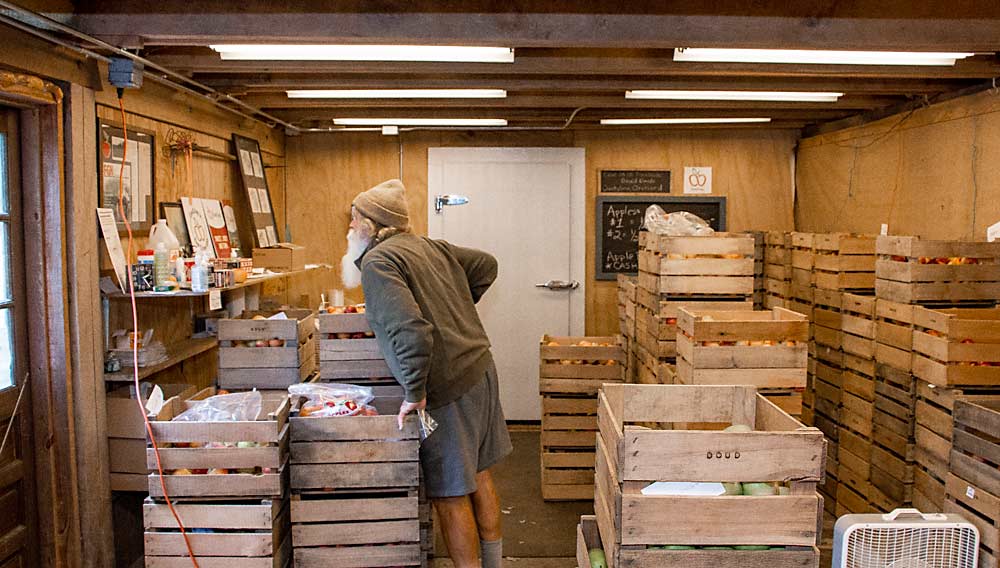
—by Matt Milkovich
Indiana growers grapple with short apple crop
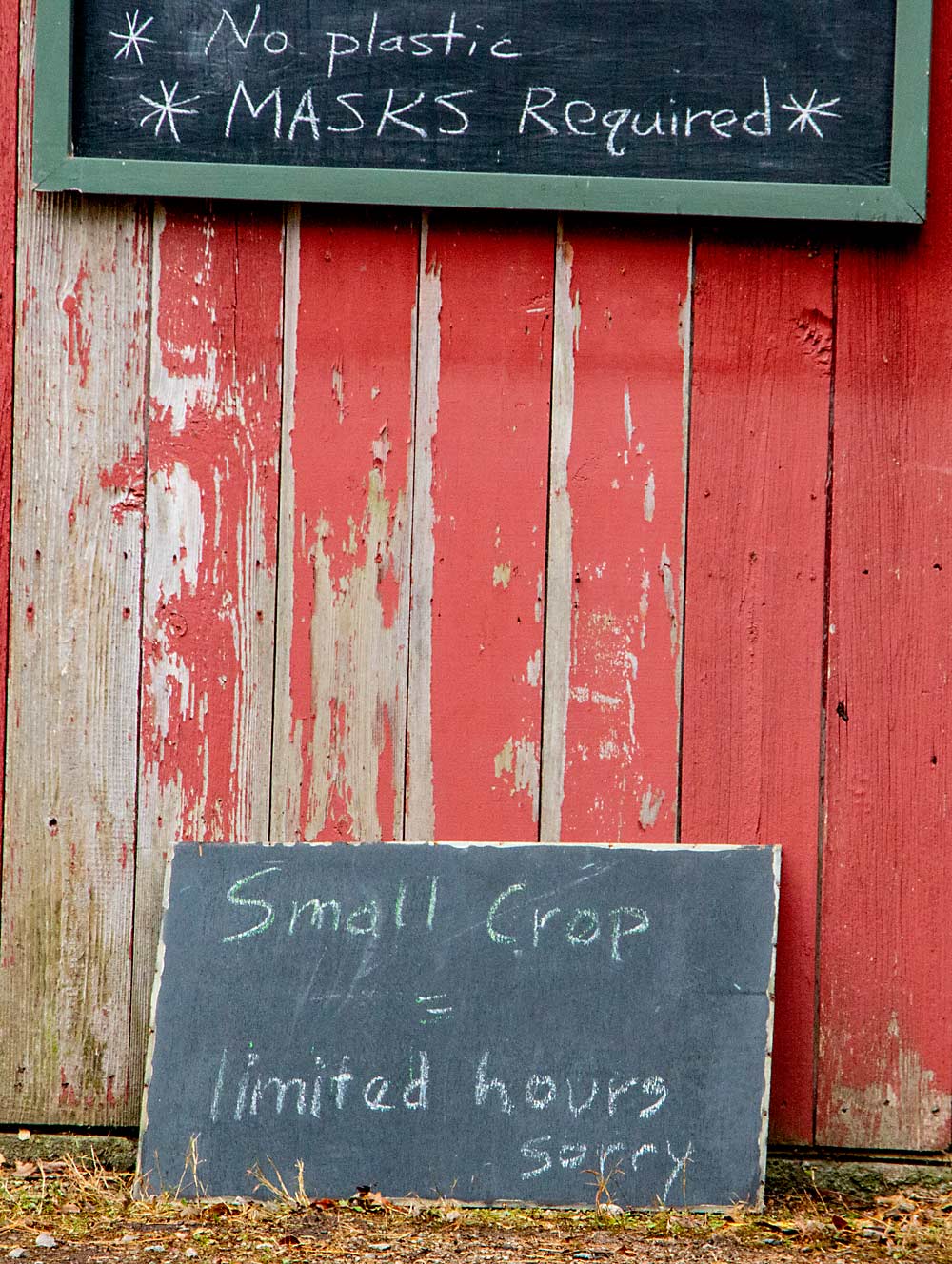
Freeze events last April and May did widespread damage to Indiana’s 2020 apple crop. Most growers there lost between 60 percent and 80 percent of their apples, said Peter Hirst, a Purdue University professor of horticulture and extension specialist.
At Beasley’s Orchard in Danville, a farm market and agritourism operation about 30 miles west of Indianapolis, temperatures reached as low as 22 degrees Fahrenheit on May 9, and stayed there for more than five hours, killing about 95 percent of the apple crop, said owner Calvin Beasley.
“That’s the worst loss I’ve seen in my life,” he said. “Others got hit this year, but we got annihilated.”
His trees were at king bloom petal fall when the freeze hit, making them particularly vulnerable. Lodi, Paulared and Honeycrisp were completely lost. Gala and Golden Delicious were mostly gone. There were a few Cortland, McIntosh and GoldRush, and a decent crop of Jonagold, for some reason, Beasley said.
Deciding how to handle such a short crop can be tricky, Hirst said.
“You can’t just walk away from the trees and go fishing,” he said. “You have to think about next year.”
Even without a crop, pests and diseases can damage trees, so each grower had to decide what level of control to apply. Should they do a full spray program or scale back? They also had to decide if protecting the cosmetic quality of a short crop was worth the expense, Hirst said.
Once they gauged the extent of the damage, Beasley and his managers decided to go ahead with a basic spray program. They want to keep pest and disease pressure as low as possible for the 2021 crop, which most likely will be heavy. With about 25 acres of apple trees, Beasley decided that such an approach was financially feasible.
They did make a few changes, however, cutting back on fungicides and sticking to protectants such as captan, which they sprayed at a lower rate. They were more deliberate about timing their Apogee (prohexadione calcium) sprays, deciding that vigor control was more important than ever, he said.
About 90 miles north of Indianapolis, near Wabash, freezing temperatures destroyed nearly 90 percent of the apple and pear crops at David Doud’s Countyline Orchard. Doud had to decide on May 10 whether to abandon what little was left or to manage it. He decided to manage the remaining crop with a full spray program, even though he knew paying 100 percent of production costs for 10 percent of a crop wouldn’t be much fun.
“I value my customers,” he said. “I did what I could for them.”
Especially dismaying was the loss of most of his Korean Giants, an Asian pear variety that’s popular with his customers.
“We usually have Asian pears until Christmas,” he said. “It’s a wonderful fruit, but I don’t manufacture them. They lasted two weekends, and that was it. That’s the nature of direct marketing in a bad climate.”
—M. Milkovich






[…] Read the full story. […]
We just tried some Evercridp apples. Got them at H‑E‑B in Texas. My wife’s a native central my gal. She LOVES them. Means a lot coming from HER! 👍🏻❤️
What a great article and an even better apple if I, and everyone else I’ve shared this gem with, do say so ourselves! My wife had a tooth replaced a while back here so in return I started peeling her apples for her, and I always peel and cut them for our two young girls. I say all that to say this, until then I’ve peeled and eaten a lot of apples but now more than ever. I always stressed to the wife what the great apples were (the ones I like) but she couldn’t always find them depending which store she had been to. I was always a fan of Honey Crisp apples, but with this new found love and appreciation for apples I have been trying some new ones. With that I’ve come across Ever Crisp and Cosmic Crisp and I now need a second job to afford to keep eating apples like we have been, not kidding. Know that your efforts and your time does not go unnoticed nor unappreciated Doug and Valerie Doud! You’ve done a tremendous job and though my wife is sick of hearing me squawk about apples, I can’t wait to tell her all about where the Ever Crisp hails from. Keep it up you two, and thank you very much from, Hamburg NY
Duane D.